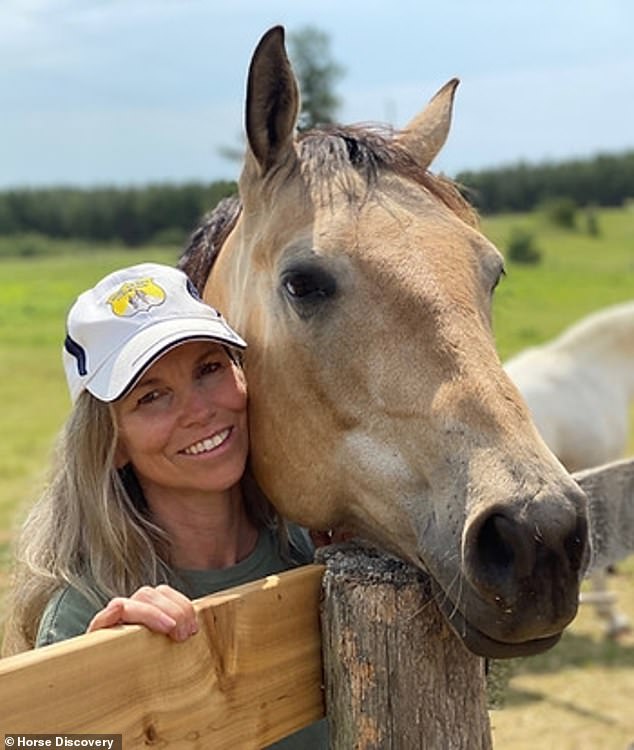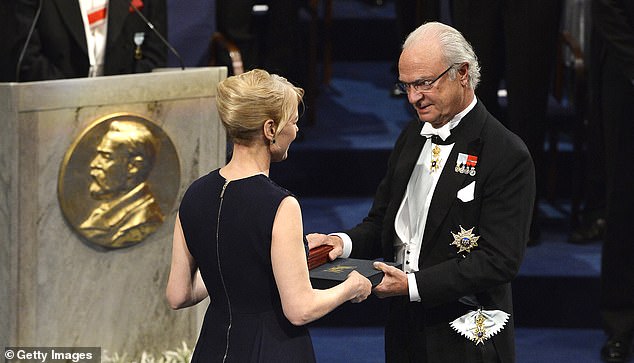Her husband sexually abused her daughter from age nine, but she refused to leave him and blamed the victim. Now a horrifying conspiracy of silence is being unmasked…
With her heartbreakingly honest stories of childhood trauma, sexual awakenings and dull, lifeless marriages, few people could write as powerfully about human nature and relationships as Alice Munro.
But until her death in May at the age of 92, fewer and fewer people knew that the Nobel Prize for Literature winner harbored a dark secret that tore her own family apart.
Just two months after being heralded in obituaries as one of the world’s top short story writers, the daughter of literary star Munro has shocked many admirers by revealing that she was sexually abused by her stepfather from the age of nine.
Andrea Skinner as a girl. She has shocked Alice Munro’s many admirers, below, by revealing that she was sexually abused by her stepfather from the age of nine

Worse — much worse, for a writer praised for her sharp and compassionate writing about the relationships between mothers and daughters — Munro chose to stay with her pedophile husband even after he was convicted of his crimes because she “loved him too much.”
Andrea Robin Skinner, 58, says the truth was suppressed for decades, not only by her family but also – because of her mother’s fame – “a lot of influential people” who knew something about what happened but said nothing. Andrea said on Facebook yesterday that “the focus of my story is the danger of silence.”
Munro’s second husband, cartographer Gerald Fremlin, first committed sexual abuse one night in 1976 at her Canadian mother’s Ontario home, where Andrea was spending her summer vacation as part of a joint custody arrangement with Andrea’s father.
Fremlin ‘climbed into the bed where I was sleeping and sexually abused me. I was nine years old.’
Describing herself as a once “happy child,” she recalled, “The next morning I couldn’t get out of bed. I woke up with my first migraine, which over the years developed into a chronic, debilitating condition that continues to this day.”
She remembers Fremlin, then in his 50s, driving her to the airport when it was time to return to her father, Jim Munro, in Victoria, British Columbia.
“In the car he asked me to play a game called ‘show me.’ When I said no, he got me to talk about my ‘sex life,’ asking me for details about innocent games I played with other children. Then he told me about his own sex life.”
Andrea, the youngest of Alice Munro’s three daughters (a fourth died shortly after birth), told her stepmother, Carole, about the abuse. Carole alerted the girl’s father. Jim, a bookstore owner who married Alice in 1951 but divorced her in 1974, did not tell his ex-wife.
He also ordered Andrea’s much older sisters, Sheila and Jenny, to keep it a secret from their mother, saying the needs of the acclaimed writer were “greater than the needs of his child.”
They were all intimidated by Munro’s growing literary fame, Jenny now admits.
Andrea also feared that her mother would “blame me if she ever found out,” as she was already paranoid that the Fremlin was prioritizing her daughter.

Just weeks after the Nobel laureate’s death at age 92, Munro’s daughter Andrea Skinner described the allegations against her late stepfather Gerald Fremlin in a moving essay
This meant that Andrea was the victim of sexual abuse for years when she came home to her mother every summer.
Fremlin, who had once been an aspiring poet, repeatedly exposed himself to her, masturbated in front of her, and made sexual advances.
“When I was alone with Fremlin, he would make lewd jokes, expose himself during car rides, tell me about the little girls he liked in the neighborhood and describe my mother’s sexual needs,” she wrote in the Toronto Star this month.
Alice Munro’s behavior was, in its own way, as appalling as Fremlin’s. When Andrea was 11, former friends of Fremlin’s told Alice that he had exposed himself to their 14-year-old daughter.
When Munro challenged him, he denied it. And when asked about Andrea, “he assured her I wasn’t his type,” she says.
‘He told me in front of my mother that many cultures in the past were not as ‘prudish’ as ours, and that it used to be considered normal for children to learn about sex by having sex with adults.
‘My mother said nothing. I looked at the ground, afraid she would see my face turning red.’
As she became a teenager, Andrea became less attractive to Fremlin, but her ordeal left her with bulimia, insomnia, and migraines, and she struggled in college.
In 1992, Andrea, then 25, broke the family’s “conspiracy of silence” after Alice Munro told her a story she had read about a girl who committed suicide after being sexually abused by her stepfather.
Munro asked her why she thought the poor girl hadn’t told her mother. A month later Andrea wrote her mother a letter telling her what had happened to her when she was little.
Munro, her daughter says, turned the scandal around, as she always did. She became the victim herself. She accused her first husband of keeping the abuse a secret to humiliate her. But she later admitted that Fremlin had confessed to her that he had “friendships” with children, which made her feel “betrayed.”
She reacted ‘as if she knew about the infidelity’.
Munro “was overwhelmed by her sense of self-injury,” Andrea recalls. “Was she aware that she was talking to a victim—that I was her child? If she was, I couldn’t feel it.”
Fremlin, meanwhile, threatened to kill Andrea if she went to the police. He wrote to her father and stepmother, claiming she had been a nine-year-old “homewrecker,” a “Lolita” seeking “sexual adventure.”
Amazingly, he did not apologize for abusing a girl, but for being “unfaithful” to Munro.
Despite everything, Munro returned after a brief separation to Fremlin, whom she first met at university and married in 1976. She remained with him until his death in 2013.
“She said she was ‘told too late,'” Andrea says, “that she loved him too much, and that our misogynistic culture was to blame if I expected her to deny her own needs, sacrifice for her children, and make up for men’s shortcomings. She was adamant that whatever had happened was between me and my stepfather. It had nothing to do with her.”
In 2002, Andrea—a yoga teacher turned therapist who works with victims of child abuse—had twins and told her mother that Fremlin would never be allowed near them. When Munro complained that it would be a “terrible inconvenience for her” because she couldn’t drive, Andrea “exploded” and refused to have anything to do with her any longer.
The literary world, however, continued to admire her and two years later Andrea could no longer suffer in silence when Munro told a newspaper interview that Fremlin was the great love of her life and that she was so happy with him. She added that she had a ‘close bond’ with all her children.

Alice Munro, represented by her daughter Jenny Munro, receives her Nobel Prize from King Carl XVI Gustaf of Sweden in 2013
Andrea went to the police — armed with the compromising letters Fremlin had sent. After his arrest, Munro screamed angrily that Andrea was a liar, according to a detective. In 2005, he admitted to assaulting her, but because he was 80, he got off with two years’ probation and was banned from having any contact with children under 14 for two years. The case received little media attention.
Who knew about Alice Munro’s horrible secret?
“Everyone,” said Andrea’s stepmother Carole, who told of a time when she was at a dinner with a journalist who asked her, “Is it true?” and she said it was true.
Both Munro’s publisher and the acclaimed biographer admit they have known about it since 2005. The latter, Robert Thacker, omitted it because he “considered it a private matter” and saw Fremlin as the perpetrator, not Munro.
Her friend Margaret Atwood, the acclaimed author of A Handmaid’s Tale, insists she only learned the “horrific” details very recently. “Why did she stay? Find me,” she says. “I think they came from a generation and a place that swept things under the carpet.”
She added: “You realise you didn’t know who you thought you knew.”
As the literary world rushes to “revalue” a revered writer, a Canadian university and her hometown are reconsidering their Alice Munro memorials. Many fans are simply wondering whether they can read her again.
And so another name has been added to the long list in the endless debate over whether it is truly acceptable to appreciate great art while condemning its flawed creator.
